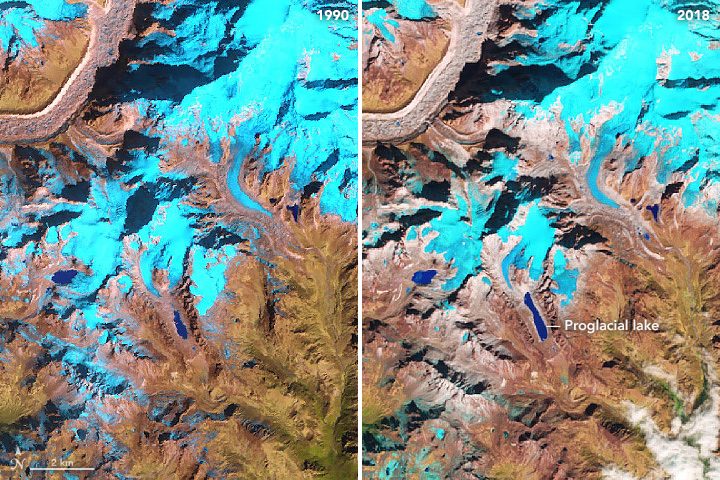


When a mountain glacier melts, a lake forms and then expands. Around the world, mountain glaciers are retreating due to rising snowlines: warmer air is rising to higher elevations, promoting more melting and less snow accumulation. (In some places, it also means more rain.) That has been the consistent observation around the world’s tallest and coldest mountains over the past few decades.
The false-color images above show a glacial lake in the Himalayas nearly doubling in length over 30 years. The images were acquired in November 1990 by Landsat 5 and November 2018 by Landsat 8. Ice is represented as light blue, while significant meltwater is dark blue. Rocks are brown; vegetation is green.
The lake sits at the foot of the Kokthang Glacier, on the south side of the Kanchenjunga Massif—the world’s third tallest mountain. In 1988, the lake in India’s Sikkim province measured 800 meters (2,600 feet) in length. By 2017, it was 1600 meters (5,200 feet), according to Mauri Pelto, a glaciologist at Nichols College.
“This lake growth is not unusual at all in recent decades in the area,” said Pelto. “Just in that little tiny region, there have been a dozens of new lakes filling formerly glacier filled valleys and fed from melting glaciers.”
Beyong Kokthang, Pelto reports that a 1500-meter long lake had formed by 2012 from the Changsang Glacier, just north of Kanchenjunga Massif. Another lake, fed by the retreating Lhonak Glacier, expanded by 1,900 meters from 1962 to 2008. Research revealed that 85 new glacial lakes formed between 2003 to 2010 in the Sikkim Himalaya region alone.
The growth of glacial lakes can increase the risk of flooding in nearby valleys. “Glacial lake outburst floods” occur when runoff water suddenly breaks through the rocks, sediment, and soil that naturally dam the lake. These outbursts can devastate nearby communities and scour the surrounding landscape. The Sikkim Himalaya region contains at least a dozen lakes that appear susceptible to outburst floods.
Kokthang’s lake, however, is not likely to be one of them. Pelto says the lake is reinforced by a wide, prominent ridge located far from the edge of the lake. The width of the ridge (around 1 kilometer/0.6 miles) means it will be a strong barrier, while the low slope provides additional stability against flowing water. The lake is also not expected to grow much bigger as much of the glacier ice is buried under sediment. The glacier on the other hand will continue to retreat and lose volume.
NASA Earth Observatory image by Lauren Dauphin, using Landsat data from the U.S. Geological Survey. Story by Kasha Patel.